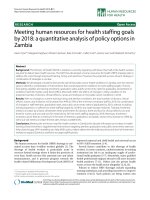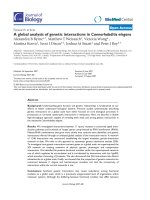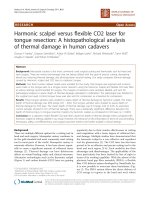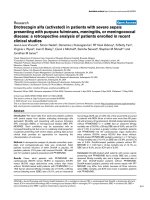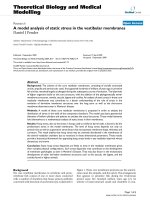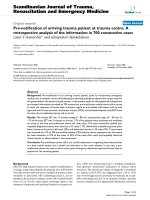A pragmatic analysis of person deixis in john kerry’s remarks on climate change
Bạn đang xem bản rút gọn của tài liệu. Xem và tải ngay bản đầy đủ của tài liệu tại đây (977.17 KB, 69 trang )
VIETNAM NATIONAL UNIVERSITY, HANOI
UNIVERSITY OF LANGUAGES AND INTERNATIONAL STUDIES
FACULTY OF POSTGRADUATE STUDIES
*********************
NGUYỄN KIỀU LƢƠNG
A PRAGMATIC ANALYSIS OF PERSON DEIXIS IN JOHN KERRY’S
REMARKS ON CLIMATE CHANGE
Một phân tích ngữ dụng về chỉ xuất về ngôi trong bài phát biểu của
John Kerry về biến đổi khí hậu
M.A. MINOR PROGRAMME THESIS
Field: English Linguistics
Code:60220201
HANOI - 2016
VIETNAM NATIONAL UNIVERSITY, HANOI
UNIVERSITY OF LANGUAGES AND INTERNATIONAL STUDIES
FACULTY OF POSTGRADUATE STUDIES
*********************
NGUYỄN KIỀU LƢƠNG
A PRAGMATIC ANALYSIS OF PERSON DEIXIS IN JOHN KERRY’S
REMARKS ON CLIMATE CHANGE
Một phân tích ngữ dụng về chỉ xuất về ngôi trong bài phát biểu của
John Kerry về biến đổi khí hậu
M.A. MINOR PROGRAMME THESIS
Field: English Linguistics
Code:60220201
Supervisor: Assoc. Prof. Dr. Ngô Hữu Hoàng
HANOI - 2016
DECLARATION
I hereby certify that the thesis entitled “A pragmatic analysis of person deixis in
John Kerry’s remarks on climate” is the result of my own research for the Degree of
Master of Arts at the University of Languages and International Studies, Viet Nam
National University, and that this thesis has not been submitted for any other degrees.
Hanoi, March 2016
Nguyễn Kiề u Lƣơng
i
ACKNOWLEDGMENTS
I would like to express the deepest appreciation to my supervisor, Associate
Professor Dr. Ngô Hữu Hoàng for helping me complete this study. This paper would not
have been accomplished without his expert, constant and valuable guidance and
encouragement. His patience and helpful criticism helped me confidently express my
ideas into this paper.
I also wish to express my sincere thanks to all my lecturers at the Faculty of
Graduate and Postgraduate Studies, University of Languages and International Studies
for their valuable lectures which have helped me a great deal in gaining a lot of
theoretical as well as practical knowledge.
My special thanks also go to my colleagues at Bill Gates International Secondary
and High Schools for their enthusiastic help and support with my teaching schedule at
school which gave me precious time to deal with my thesis.
Finally, I would also like to express my deep gratitude and love to my devoted
parents and my sister who gave me time and encouraged me to overcome all obstacles
during the accomplishment of this study.
ii
ABSTRACT
This study is conducted to identify the person deixis used in John Kerry‟s
Remarks on Climate Change and the purposes of its usage seen from political angle.
Qualitative research methodology is applied to analyze the data. From the point of view
of several theoretical concepts in the field of pragmatics namely person deixis, referents,
the role of context, person deixis in the speech is investigated according to its
subdivisions. The results reveal that “I” and “we” are dominantly employed by the
speaker. “We” functions to involve himself as participant while “I” functions as self
positioning. Following the evaluation of the results, a discussion of the person deixis
usage and its role on political goals is presented which shows that “we” is employed to
preserve friendship between John Kerry and the audience. The last pages of this study are
devoted for the implications for teaching and learning pragmatics as well as suggestions
for further research.
iii
TABLE OF CONTENTS
Declaration ………………………………………………………………………..………..….....i
Acknowledgements …………………………………………………………...…………………ii
Abstract ………………………………………………………………………………………....iii
PART 1 INTRODUCTION
1. Rationale for the study ............................................................................................................ 1
2. Aim and scope of the study ..................................................................................................... 2
2.1. Aim of the study…………………………………………………………………............2
2.2. Research questions………………………………………………………………............2
2.3. Scope of the study………………………………………………………………………..2
3. Design of the study .................................................................................................................. 2
PART 2 DEVELOPMENT
CHAPTER I A BACKGROUND TO THE STUDY ..................................................................... 4
1. Political discourse.................................................................................................................... 4
2. Person deixis............................................................................................................................ 5
2.1. Deixis…………………………………………..…………………………………….…..5
2.2. Person deixis……………………………………………...……………………………...6
2.3. The Role of Person deixis in Political Communication………………………………....8
3. The Role of Context in Using Deixis .................................................................................... 10
3.1. The Situational Context/ Exophoric Reference .............................................................. 11
3.2. The Background Knowledge Context............................................................................. 11
3.3. Co-textual Context…….………………………………………...……………………...13
4. Political Discourse Propaganda ............................................................................................. 14
5. Related Study ........................................................................................................................ 15
CHAPTER II METHODOLOGY ................................................................................................ 16
1. Research methods and instruments ....................................................................................... 16
2. Data of the study.................................................................................................................... 16
3. Data analysis .......................................................................................................................... 17
CHAPTER III FINDINGS AND DISCUSSION .......................................................................... 18
1. Kinds of Person deixis used in John Kerry‟s Remarks on Climate Change ......................... 18
2. Referents and Political Purposes of Person deixis used in John Kerry‟s Remarks on Climate
Change ....................................................................................................................................... 19
iv
2.1. First Person deixis........................................................................................................... 19
2.1.1. First Person Singular .................................................................................................... 19
2.1.2. First Person Plural ........................................................................................................ 23
2.2. Second Person Deixis ..................................................................................................... 31
2.2.1. Second Person Singular ............................................................................................... 32
2.2.2. Second Person Plural ................................................................................................... 32
2.3. Third Person deixis ......................................................................................................... 33
2.3.1. Third Person Singular .................................................................................................. 33
2.3.2. Third Person Plural ...................................................................................................... 36
PART 3: CONCLUSION
1. Recapitulation ........................................................................................................................ 40
2. Implications of the study ....................................................................................................... 41
2.1. Implication for teaching pragmatics…………………………………………...……….41
2.2. Implication on learning pragmatics…………………………………………………….41
3. Limitations of the study ......................................................................................................... 42
4. Suggestions for further research ............................................................................................ 42
REFERENCES………………………………………………………………………………….43
APPENDIX……………………………………………………………………………………….I
v
LIST OF ABBREVIATIONS
1. US
: United States
2. L2
: Second Language
vi
LIST OF FIGURES
Figures
Page
Figure 1:
Subdivision of singular person deixis
7
Figure 2:
Subdivision of plural person deixis
7
Figure 3:
References of context
13
Figure 4:
Kinds of person deixis used in John Kerry‟s Remarks on Climate
Change
18-19
Figure 5:
Occurrence of first person singular
20
Figure 6:
Occurrence of first person plural
23
Figure 7:
Occurrence of second person deixis
31
Figure 8:
Occurrence of third person singular
33
Figure 9:
Occurrence of third person plural
36
vii
PART 1
INTRODUCTION
1. Rationale for the study
There is a close relationship between language and politics. According to Adetunji
(2006:1), the former is the medium which the society used for the purposes of
communication and cohabitation while the latter is considered the ideas and activities
used for gaining and exercising power in society. In addition, Wodak and de Cillia
(2006:709) claim that there is no clear-cut distinction between language and politics, and
they are two overlapping subjects. As a result, when investigating one of these subjects,
the other also needs to be concerned.
Wind et al. (1989:26) highlights that deixis is a universal element of languages. It is a
linguistic phenomenon attracting much concern from linguists. Deixis is used widely by
people from all over the world, regardless of personality, the culture and country they
come from. However, the way people employ deictic expressions in their communication
differs from one person to another owing to their distinctive characteristics, education
level, social class, communicative purposes and so forth. Among the five common types
of deixis in languages: person, time, place, discourse and social deixis, person deixisis is
perhaps the worthiest considering as it deals with the roles participating in a speech
event. This study is aimed to investigate how person deixis is employed by John Kerry as
a speaker with great power and potential influence on the audiences.
It is worth mentioning that in politics speaker normally adjust what they say to suit
the social-political reaction they anticipate from the audience (Joseph, 2006:43). The
forms of adjustment itself vary from metonymy to the use of person deixis (Beard,
2000:24-36). Person deixis, within its simplicity, contains broad interpretation since it is
interpreted based on its context, not dictionary meaning.
1
The existence of significant meaning of deixis in a political speech leads to the belief
that the deictic expressions in John Kerry‟s speech also have significant interpretation
beyond their dictionary meanings. That is why this speech is chosen to be analyzed.
2. Aim and scope of the study
2.1.
Aim of the study
The aim of this study is to enrich the knowledge of deixis in use, especially to investigate
person deixis in political speech. Consequently, communication can be enhanced.
This study is expected to give significant knowledge to the students about political
communication; hence, they can be more aware of statements coming from politicians. In
terms of English teaching, this study is expected contribute to the understanding of deixis
and its use in an English utterance, especially when it is spoken by a native speaker.
2.2.
Research questions
To achieve the aim of this research, the following questions are set:
What kinds of person deixis are used in John Kerry‟s remarks on climate change?
What are the referents of person deixis used in John Kerry‟s remarks on climate
change?
What are the political communication purpose(s) achieved by using the person
deixis in the speech?
2.3.
Scope of the study
This small piece of work is not expected to cover all the aspects relating to deixis. Owing
to the time constraint and knowledge of the writer, this study is limited to the use of
person deixis in only one speech. Other types of deixis namely spatial, temporal, social,
and discourse deixis are beyond the scope of the study.
3. Design of the study
The study is presented as follows.
2
Part 1 – Introduction mentions some suggestions and fundamental ideas to lead in the
main part of the thesis. Chapter I includes “the rationale of the study”, “the aim of the
study”, “the research questions”, “the method of the study”, “the scope of the study”, and
“the design of the study”, respectively.
Part 2 – Development contains of three chapters.
Chapter I – A background to the study deals with the theoretical background that
inspires the thesis and the related literature review of person deixis in political
communication.
Chapter II – Methodology presents the methodology and procedure in data collection
and analysis applied in this study. The writer describes her research design and the way
she collected, classified and analyzed the data.
Chapter III - Findings and Discussion analyzes the collected data then withdraws the
final conclusions of the thesis. Further discussion on findings will be presented with
examples that emerge from the data analysis as well as the personal interpretations and
comments from the author.
Part 3 - Conclusion gives the summary of the thesis by providing answers to the
research questions presented. Implications for teaching and learning pragmatics derived
from the thesis are also revealed in this chapter. Finally, the writer will review the
limitations of this study and make suggestions for further research.
3
PART 2
DEVELOPMENT
CHAPTER I
A BACKGROUND TO THE STUDY
1. Political discourse
Discourse is such a broad term with many definitions, ranging from linguistics through
other disciplines. Teun A van Dijk generally considered discourse as text in context
(Horváth, 2009: 45). From this, it can be concluded that the term “discourse” is wider
than “text” as “discourse” refers to the whole process of social interaction of which a text
is just a part” (Fairclough, 1989: 24).
According to Schaffner (1996), political discourse, as a sub-category of discourse in
general, can be based on two criteria: functional and thematic. Political discourse is a
result of politics and it is historically and culturally determined. It fulfills different
functions due to different political activities. It is thematic because its topics are primarily
related to politics such as political activities, political ideas and political relations.
Van Dijk (2009: 1) emphasized that a discourse cannot be fully understood without
understanding its context. Therefore, in order to achieve a comprehensive analysis, the
context of the John Kerry‟s remarks on climate change was explained. The writer focused
on information about the speaker, John Kerry and the situation when the text was
delivered.
On February 1, 2013, John Forbes Kerry was sworn in as the 68th Secretary of State of
the United States, becoming the first sitting Senate Foreign Relations Committee
Chairman to become Secretary in over a century. Secretary Kerry joined the State
Department after 28 years in the United States Senate, the last four as Chairman of the
Senate Foreign Relations Committee. As Secretary of State, all his speeches received
much attention from the public. Among those speeches, the writer chose his Remarks on
Climate Change as the data for analysis. John Kerry‟s remarks on climate change were
4
delivered to a group of students and government officials at on February 16, 2014 at an
American cultural center in Jakarta, Indonesia. The speech was delivered a day after the
U.S and China issued a joint agreement saying that they had agreed on steps to carry out
commitments to cooperate closely in reducing the effects of climate change. U.S.
officials were hoping that other nations, particularly those in the developing world, will
follow suit. John Kerry chose Indonesia for the first of what is to be a series of speeches
on the topic partly because as he said in his speech, this country, as an archipelago of
more than 17,000 islands, was “on the front lines of climate change” and some of the
most vulnerable to the effects of global warming. In his speech, John Kerry highlighted
that climate change is real and call Indonesian people and authorities to step up effort to
combat it.
2. Person deixis
It is believed that language does not only possess a specific structure but also a
variety of functions. These language functions belong to the field of pragmatics which
concerns with the study of meaning as communicated by speaker (or writer) and
interpreted by listener (or reader). Pragmatics is closely related with the context or
setting of an utterance instead of the structure of the utterance itself. An utterance is
interpreted not only based on its words‟ meaning, but also based on its context or factors
outside of the denotative meaning itself. Such scope of Pragmatics would include the
study of deixis.
2.1. Deixis
According to Yule (1996: 9), deixis is the technical term for one of the most basic
things we do with utterances. The term deixis is gained from the Greek word meaning
pointing or indicating (Levinson 1983: 54). It signifies different things to different people
(Cruse 2000: 319).
“Deixis introduces subjective, attentional, intentional and of course contextdependent properties into natural languages” (Levinson in Horn/Ward 2006: 97). In
addition, Levinson makes up his mind that “the single most obvious way in which the
5
relationship between language and context is reflected in the structures of language
themselves, is through the phenomenon of deixis” (1983: 54). The importance of deictic
information in interpreting utterances is best demonstrated by what happens when such
information is missing (Fillmore 1975: 38-39 in Levinson 1983: 54).
Deixis is traditionally divided into three categories: person, time, and place deixis.
In Yule (1996) and Cruse (2000), the term „temporal deixis‟ is used instead of „time
deixis‟ and the term „place deixis‟ is replaced by „spatial deixis‟. Following Lyons (1986,
1977a) and Fillmore (1972b, 1975), Levinson adds to the traditional categories two more
deixis types: discourse (or text) deixis and social deixis (1983: 62). As the purpose of this
study is analyzing person deixis, the writer only reviews theoretical background about
person deixis.
2.2. Person deixis
The different roles that individuals play in the speech event (speaker, addressee,
and other) are directly reflected by the grammatical category of person (Levinson in
Horn/Ward 2006: 112). The two semantic features of speaker inclusion (S) and addressee
inclusion (A) capture the traditional person paradigm: first person (+S), second person
(+A, -S), and third person (-S, -A). Additionally, Levinson emphasizes that “although
person deixis is reflected directly in the grammatical categories of person, it may be
argued that we need to develop an independent pragmatic framework of possible
participant roles, so that we can see how and to what extent these roles are applied in
different languages” (1983: 68).
Yule (1996: 11) suggests that in deictic terms, third person is not a direct
participant in basic (I-you) interaction (outsider) which results distant. Thus, third person
pronouns are consequently distal forms in the term of person deixis. She also mentioned
that for pronoun “we” there is potential ambiguity which is possibly cause
misinterpretation. There is exclusive” we” (speaker plus other(s), excluding addressee)
and an inclusive “we” (speaker and addressee include). Furthermore, Levinson (1983: 69)
mentions that “we” does not always mean plural: the inclusive-exclusive distinction also
6
appear in “let‟s go” (inclusive-to some friends) and “let us go” (exclusive-to someone
who has captured the speaker and friends).
The summary of person deixis kinds is tabulated as follow:
Figure 1: Subdivision of singular person deixis
SINGULAR
Subject
Object
Reflexive
Possessive
First person
I
Me
Myself
My
mine
Second person
You
You
Yourself
your
yours
Masculine
He
Him
Himself
His
his
Feminine
She
Her
Herself
Her
hers
Neuter
It
It
Itself
Its
its
Third
person
Figure 2: Subdivision of plural person deixis
PLURAL
Subject
Object
Reflexive
Possessive
First person
We
Us
Ourselves
our
ours
Second person
You
You
Yourself
your
yours
Third person
They
Them
Themselves
their
theirs
(Source: Cornelius Puschmann: Thank you for thinking we could: Use and function of
interpersonal pronouns in corporate web logs [12/28/09])
7
2.3. The Role of Person deixis in Political Communication
It has been mentioned that deixis, within its simplicity, contained broad meaning
of interpretation, especially when it comes to political field. It is based on the idea that in
order to gain voice from the society, the way of communicating with the society must be
arranged as interesting as possible to make a lasting impression to the recipient.
Therefore, when deixis is applied in a speech, it is believed to give significant
contribution to the overall impact of the speech.
Beard (2000: 24) claims that pronoun preference is always important for the use of
political persuasion. For example, pronoun „your‟ can mean given an immediate sense
that the reader (s) is being addressed personally and the use of pronoun „we‟ for inclusion
and exclusion. Furthermore, Beard (2000: 44-45) points out essentially five ways
politicians can introduce a measure that they intend to apply, they are:
First person singular pronoun “I‟ as in “Today I intend to reduce taxes by 20
percents”.
First person plural pronoun „we‟ as in “Today we intend to raise the taxes by a
mere 5 percent”.
Referring to position, like “The Chancellor must raise taxes for the long-term good
of the nation‟s economy” or the role as part of the government: “The government
must raise taxes . . .”
No agentive pronoun at all and only use agentless passive without direct
responsibility for action given, as in “Today it has been found necessary to raise
taxes by 20 percent.”
Using metonymy: “This budget will help all those on low incomes.”
Referring to number one and two, it means that when politicians make a speech, they
have two sets of first pronouns. They can use first person singular (I, me, myself, or
mine) or first person plural (we, us, ourselves, and ours). According to Beard (2000: 45),
the first person plural forms can have a range of references:
They can refer to „I‟ plus one other; i.e. we = the leader+ vise
8
They can refer to „I‟ plus a group; i.e. we = the leader + government and/ or
political party
They can refer to „I‟ plus the whole country; i.e. we = the leader + society
They can refer to „I‟ plus the rest of humanity; i.e. we = the leader + people
everywhere.
Not only does Bread mention two sets of first pronouns but he also clarifies the
advantage and disadvantage when using them:
Singular pronouns (I/me/myself/mine)
Advantage:
- show a clear sense of personal involvement on the part of the speaker,
which is especially useful when good news is delivered.
Disadvantages:
- show all too clearly where blame lies if something goes wrong.
- can be seen as too self- important, with the individual speakers placing
themselves above or outside the collective responsibility of their
colleagues.
Plural pronouns (we/us/ourselves/ours)
Advantages:
- help share the responsibility, especially when the decisions made are
thought to be rejected by the society.
- show the politician in touch with all of the country, even all of the
world.
Disadvantage:
- individual does not gain so much credit when things go well.
9
The various objectives of the use of pronoun above make politicians and their speech
writers have some difficulties in making decision of right time to use pronouns that will
keep appearing in their speeches including:
How much responsibility are prepared to take on themselves?
How much responsibility for success are they wiling to share with other
colleagues?
How confident are they that the whole groups of people share their views?
How much responsibility for failure are they prepared to accept as their own?
(Bread 2000: 45-46)
Finally, if we summarize all the explanation above, we can find an easy way to see
how those points give significant effects to the overall speech content.
3. The Role of Context in Using Deixis
Hymes (1964) in Brown and Yule (1983: 38) specifies the features of context
which may be relevant to the identification of a type of speech event. They are addressor
and addressee. “The addressor is the speaker or writer who produced an utterance and
the addressee is the hearer or the reader who is the recipient of the utterance” (Brown and
Yule 1983: 38). Knowing who are the speaker and the hearer makes it possible for
analysts to predict and interpret his/her utterance by extra linguistic factors of both the
speaker and the hearer, thus the more analysts know about the features of context, the
more likely he is to be able to predict what is likely to be said (Brown and Yule 1983: 3840). Context covers the identities of participants, the temporal and spatial parameters of
the speech event, the beliefs, knowledge and intention of the participants in the speech
event (Levinson 1983: 6).
There are three kinds of context that influence the interpretation of an utterance; they are
the situational context, the background knowledge of context, and the co-textual context.
10
3.1.
The Situational Context/ Exophoric Reference
Situational context means that the surroundings or the situation can provide the meaning
to a word, so the words do not have to be explicitly stated (Cutting 2002: 57). The
example of situational context is as follow:
There is a conversation between A and B who are sitting with the curtains drawn.
A: God it‟s hot here
B: Is it?
C: Yeah, really. Are you shutting out this lovely sunshine?
(Cutting 2002: 55)
A‟s “God it‟s hot here” has place deixis “here” pointing to the room that they are in. B
and C know that A means the room, not the whole building or the whole city. The
sentence “are you shutting out this lovely sunshine?” contains spatial deixis pointing to
the sunshine shining through the curtains (Cutting 2002: 56). In those examples, A does
not say “it‟s hot here in this lecturer room” and C does not say “Are you shutting out this
lovely sunshine that is coming through the curtains at the window behind you?” because
the hearer have known the place they refer to.
3.2.
The Background Knowledge Context
Background knowledge context means that speakers assume a common knowledge of the
course, knowledge that is only known by the members of the speakers. There are two
kinds of background knowledge context; they are cultural general knowledge and
interpersonal knowledge.
3.2.1. Cultural general knowledge
According to Cutting, cultural general knowledge is a common knowledge that most
people carry with them in their minds, about areas of life (2002: 5). For example:
11
B, an Englishman, had planned to go to Spain for Easter but could not afford the
tickets; he tells A, a Scottish woman, that he ended up going hill walking in Arran,
an island off the west coast of Scotland.
A: So you went to Arran. A bit of a come-down isn‟t it! (laughing)
B: It was nice actually. Have you been to Arran?
A: No I‟ve not. Like to go.
B: Did a lot of climbing.
A: (heh)
B: I went with Francesca and David.
A: Uhuh?
B: Francesca‟s room-mate. And Alice‟s – a friend of Alice‟s from London.
There were six of us. Yeah we did a lot of hill walking. We got back.
Michelle and I got home she looked at her knees. They were like this.
Swollen up like this. Cos we did this enormous eight hour stretch.
A: Uhm.
(Cutting 2002: 3)
In this example, when B said that he and his friends went „hill walking‟, that they walked
for eight hour there, or that the walk was strenuous enough to make somebody‟s knees
swell, A does not appear to be surprised because A and B share cultural knowledge about
the low mountains on the island (Cutting 2002: 5).
3.2.2. Interpersonal background knowledge
Interpersonal background knowledge refers to specific and possibly private
knowledge about the history of the speakers themselves (Cutting 2002:5). In example
(11), it is clear that both A and B know who „Michelle‟ is: B would have told A in
12
previous conversation that his wife‟s name is „Michelle‟. Cutting also states that
knowledge acquired through previous verbal interactions or joint activities and
experiences is interpersonal knowledge (2002:6).
3.3. Co-textual Context
Co-textual context is the context of the text itself, known as the co-text (Cutting
2002: 8). It means that the context is not depending either on the environment nor the
speaker, yet the composition of the text itself. There are two kinds of co-text, they are
endophoric reference/ endophora and exophoric reference/ exophora.
3.3.1. Exophora
Exophoric reference is when there is no previous mention of the referent in the
text, depending on the context outside of the text (Cutting 2002: 9).
3.3.2. Endophora
If the pronouns refer to items within the same text, it is called endophoric
reference (Cutting 2002: 9). There are two types of endophora, they are anaphora and
cataphora, and he describes each type as follow:
The summary of reference is as follow:
Reference
Exophora
Endophora
Anaphora
Cataphora
Figure 3: References of context
Source: Joan Cutting: Paragmatics and Discourse (2002:10).
13
4.
Political Discourse Propaganda
Beard (2000: 53) believes that making a speech is a vital part of the politician‟s
role announcing policy and persuading people to agree with him. This is in line with the
purpose of a speech that the speech maker attempts to convince the recipients to agree
with the content of the speech, therefore, the language in political speech has been
arranged well for the audience‟s further political action.
In the past years, many researchers have studied “propaganda technique”. One of
the noticeable theories about propaganda was developed by Horold D. Lasswell, a
political science professor at the University of Chicago in 1927. He explains that the
multiplication of those stimuli which are best calculated to evoke the desired responses
may be said to be concerned with the propagandist, and with the nullification of those
stimuli which are likely to instigate the undesired responses. The problem of the
propagandist is to multiply all the suggestions favorable to the attitudes which he wishes
to produce and strengthen, and to restrict all suggestions which are unfavorable to them.
In this sense of the word, suggestion refers to cultural material with a recognizable
meaning instead of individual psychology which to mean the acceptance of an idea
without reflection (Lasswell 1927: 630-631).
There are four major objectives of propaganda (Lasswell, 1927, in Pinkerton,
2006: 26), they are:
1. To mobilize hatred against the enemy
2. To preserve the friendship of allies
3. To preserve the friendship and, if it is possible, to procure the cooperation of
neutrals.
4. To demoralize the enemy
There are seven propaganda devices of propaganda, they are name calling, glittering
generality, transfer, testimonial, plain folks, card stacking and ban wagon (Sproule,
2001:136).
14
5.
Related Study
In 2006, Akinbiyi Adetunji analyzed inclusion and exclusion in two Nigeria
President Olusegun Obasanjo's Speeches. In Text A, the deictic centre is nearer the plural
"we" than the usual, singular "I". This reflects the all-embracing content and context of
the speech, which is given away by the rapport-inviting opening sequence,
"Distinguished Ladies and Gentlemen". As such "we", the commonest personal deictic in
the speech, has been deliberately employed by the speaker to convince and probably
manipulate the audience to reason like him and help him in sharing the load of
responsibility. In Text B, the deictic "I" preponderates, essentially because the speaker
speaks from a personal point of view, verbalising a particular conviction whose general
(the populace, its "royal" arm) acceptability we may not be sure of. His occasional use of
"we" is sheerly an appeal to "ideological common sense" (Fairclough 1989: 88), a subtle
conscription suggested by the speech's opening salutation "Fellow Nigerians"(a formulaic
introduction made popular by Nigerian military coup announcers for public acceptance.
In sum, there is an essential difference between the situations of deixis in Texts A and B.
While the speaker in Text A seeks an acceptance from and a collaboration with the
audience, the speaker rejects the ways of and vilifies the referent "he", in Text B. Text A
is thus speaker-inclusive, a macro-text of "inclusion". Text B presents a self-exclusive
speaker. Text B is, as such, a macro-text of "exclusion".
Another research on the same topic titled “From solidarity to antagonism: The
uses of the second-person singular pronoun in Chinese political discourse” is conducted
by Kuo in 2002. Kuo (2002) has explored the use of deixis for indexing political debates.
Two televised debates of the 1998 Taipei mayoral election were analyzed. He reports that
the frequency of the second-person singular pronounce “ni” (you) in the second debate is
increasing significantly in comparison to the first debate. His study shows that the use of
second-person plural “ni” (you) is deployed differently by the candidates. Kuo suggests
that the different uses of “ni” in the two debates signal the change of interactive goal of
the debate from establishing or reinforcing solidarity with the audience to expressing
antagonism or attacking the opponents.
15
CHAPTER II
METHODOLOGY
1. Research methods and instruments
Working as the descriptive research, the study employs qualitative method as the major
technique. From some descriptive research types of study, a document analysis is used
since the information obtained in this study is document in the form of speech transcript.
Qualitative research is best chosen for this study since the data used is deictic expressions
in the form of words. Therefore, the frequency of the person deixis that appeared is only
used to explain the pattern of the deixis occurrence. Along with document analysis,
referencing to publications is considered one of the most fundamental techniques since it
provides the theoretical and empirical bases for this study.
In qualitative research, the researcher with or without any other personal helping is
considered as the main determiner in collecting the data (Lichtman 2009: 16; Merriam
2009: 39). This thesis is a qualitative study; therefore, the researcher will be the
instrument and she will use the documentary evidence in the analysis. She will not use
any questionnaire to solve the problem.
2. Data of the study
The data of this study is the person deixis in the form of words and phrases used in the
speech. The transcript of the speech is obtained from John Kerry‟s remarks on climate
change on the website of U.S. Department of State.
The writer focuses on the transcript to find the person deixis used in the speech. In
order to find out all the instances of person deixis, she used the tool “Find” in Microsoft
Word. To verify the result, she used a website called Writeword. This website offers
Word Frequency Counter, which counts the number of words used in a text and
frequency. The results are listed from the words with the highest occurrence to the one
with the lowest occurrence. The writer compared the results from Microsoft Word with
those from the website to assure that they were exactly the same. Later on, she classified
16




